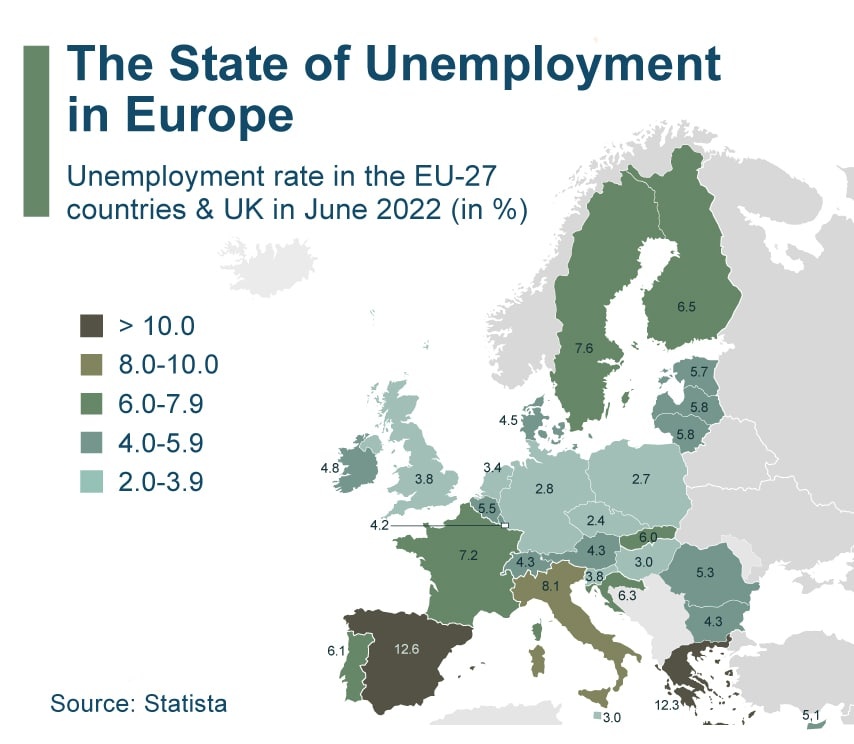Introduction
The world around us is constantly in a state of flux. Technological, social and environmental changes have become quite unpredictable and have gradually contributed to employment situations globally. Mass occurrences worldwide have also profoundly impacted the way life and work function in Europe. No one is spared from these inevitable changes, but the labor market, in particular, seems to be having the worst of it across the continent.
The world economic outlook for July 2022 read «Gloomy and More Uncertain» as a world post-covid sort to recover from the downturn the virus brought to the economy in 2020. 2021 saw a recovery and growth level, but an overarching gloomy cloud loomed over global economies. This, according to the IMF, is a result of «higher-than-expected inflation worldwide – especially in the United States and major European economies – triggering tighter financial conditions; a worse-than-anticipated slowdown in China, reflecting COVID- 19 outbreaks and lockdowns; and further negative spillovers from the war in Ukraine.» Unfortunately, some of these problems are problematic to the world; their effects have become much more regionalized in Europe.
Wars and civil unrest across the globe, especially close to Europe, have had their effects on the European economy. They have invariably plagued the rest of Europe with a rising refugee problem and a labor skill gap. Countries like France, the UK, Germany, and Italy are projected to either have prolonged growth in the last two quarters of the year, or they might even see slight contractions. This spells not-so-good news for the labor market all over the continent.
As it stands, Spain, Greece, and Italy have the most overall unemployment rates, according to Statista, with each state having 12.6 percent, 12.3 percent, and 8.1 percent, respectively. Eurostat further states that as of June 2022, the EU economy and the Euro area had an employment rate of 6.0 percent and above. The unemployment rate may be interpreted as an indication of unused labor capacity from an economic perspective.

This inevitably raises the question, is there a labor challenge in the EU, including Britain? If so, what are these challenges, and is there a role L&D can play alongside IT solutions in lessening the effects of these challenges or bringing about a long-lasting solution to help the EU move forward?
Labor shortages in Europe. How serious is this challenge?
The European labor market had been witnessing a downturn even before Covid came into the scene. In 2019, Eurofound made it clear that 39 percent of European manufacturing companies had indicated an increase in labor shortages before the pandemic. The pandemic increased this problem as the UK reported a 30 percent increase in job vacancies after the pandemic. This is not a regular phenomenon as this is the first time since public records that there are more job vacancies than unemployed people in Britain’s history.
It becomes an Irony when it is understood that there are more jobs than unemployed people, yet recruiters and employers cannot fill these vacant positions.
This problem is not restricted to Britain alone, as French tire company Michelin reported that it could not meet customer demands in 2021 due to labor shortages.
While unemployment and labor shortages or labor gaps sound alike, they are not the same. Unemployment refers to a situation where someone who can work and is willing to work has no job to do. On the other hand, labor shortages refer to a problem whereby there are either insufficient workers to fill specific roles or the available workforce is not qualified to fill the available jobs.
The situation in Europe, in truth, is quite tricky and could further increase the economic contraction if individuals and companies do not implement proper solutions. The question then arises, what are the major causes of this problem?
European labour trends & how they affect companies & employability
It becomes easier to dissect how L&D can offer solutions with the help of IT when we can identify prevalent trends and how they should be approached. Labor shortages in Europe result from a series of complicated and intricate reasons, but here are a couple of directions to give a frame of reference for better understanding.
The Pandemic Had A Profound Declining Effect On Employment
The pandemic greatly affected how work was done and the skills required for employment. The pandemic was responsible for declining 5 million workers from the labor force just in the first half of 2020. It did not stop there; due to the nature of the pandemic, non-essential workers were not allowed to work. There were temporary and permanent layoffs because many businesses were not active. Young people also got the short end of the stick as they experienced more job losses. They were also easily laid off due to the sort of position they often occupied. The effect of the pandemic also included a reduction in pay for many, resulting from fewer work hours.
Advancements In Technology & The Need For More Tech Workers
It is not meant to be scary, but technological improvement would ease many routine tasks. The manufacturing industry is one area where this trend might become much more predominant. Many sectors, including healthcare, have begun to include more technological elements in their day-to-day affairs. This does not negate the need for skilled labor; instead, it opens a labor gap that most people do not quickly fill. At the same time, this might cause a rise in unemployment levels; it also leaves a gap for those who can adequately handle these changes, creating a labor shortage.
Across the continent, IT workers are increasingly in demand. A notable example is Belgium, where positions for IT developers, functional analysts, business analysts, data scientists, and cybersecurity specialists are highly sought after. Roles in artificial intelligence are also open. Countries like Germany are beginning to source these positions to candidates outside their countries, going as far as Eastern Europe for qualified candidates.
Unsatisfactory Working Conditions
Many people are beginning to abandon their previous employment in the United States. This is tied to many reasons, but they are usually linked to the satisfaction derived from their job and the working condition presented to them. The employee-employer relationship now plays a significant role in how many workers pick up roles, and the pandemic, in one way or another, increased the boldness of workers to switch jobs when they are not comfortable with their working conditions. This includes work mobility or the work-from-home option introduced during the pandemic. Other options such as pay and office management also play a role. Invariably, this has created a hole in some labor markets, and many employers are looking for ways to clog this gap. To this effect, there is a response to the increment of salaries and other compensations, especially in tech-related fields. Countries like the Netherlands and Ireland have seen a steady rise in pay for workers with tech skills.
Availability Of Labor Without The Complementary Skillset
A reflection of all that has been noted earlier as many roles need filling, but the number of people available to fill them is not qualified. Many European countries, including the United Kingdom, the Netherlands, Belgium, Ireland, and Germany, have faced an increase in the time it takes to fill job posts. This shift has been most noticeable in highly skilled areas where demand has surpassed supply. Overall, the time to fill these high-demand areas has increased by over a week compared to the previous year.
Looking at individual nations, the Netherlands has seen an increase in vacancies as it has eased its COVID-19 prevention efforts, leading to fewer candidates and a more extended period to find them. Due to more IT projects across the country and insufficient candidates to fill the positions, Germany also faces a shortage of qualified candidates.
The role of learning & development (L&D)
Looking at all of these trends, one thing becomes clear; there has to be a way for companies to salvage the situation and turn things around in their favor. That is where each company’s Learning & Development Department comes into play. In these critical times, the learning and development department has a significant role, especially working with the Human Resources department.
In a survey of a large pool of executives and company leaders, one of the most notable effects of a functional Learning & Development Department was the success rate in helping employees skill up and fill in the gaps in their existing position. This just counts as one of the many functions the Learning & Development Department plays in your company, but how can this department be of benefit in helping a company close the labor shortage gap?
Essentially L&D’s primary role is to facilitate staff growth that contributes to the company’s overall objectives. What possible ways can L&D do this?
Teach & Upskill Workers For The Future
Setting up training using the right training platforms and creating systems that allow easy access for employees to training materials and actively guide them through this process. The learning and development department has a role; to help workers learn and develop their skills to meet the demand of their job. If this role is considered more, this department can become the most critical department in the company, especially during a labor shortage such as is sweeping the EU.
Create & Heighten Expectations During The Initial Onboarding
The era after the Pandemic has been known as the «great resignation» era, where workers are no longer worried about quitting their jobs and adequately analyzing what they intend to do with their careers. In this sort of era, retention is vital. When bringing in recruits, a detailed onboarding process that helps give vision and clarity to recruits can help retain them for the long term. It has also been discovered that 87% of millennials, who currently form about 34% of the active workforce in Europe, are more likely to stay at a job that promises them growth opportunities than one that does not. It is also important to note by 2025, millennials will form 75% of the working population globally.
Discover Hidden Talent Within Your Existing Employee Pool
Sometimes the problem of the labor gap can be filled within your own company. One of the responsibilities of the L&D is to create avenues where employees can learn new skills to fit into new roles. As we noted earlier, a significant motivation for many employees is the desire to grow at their jobs. Opening them up to new areas can help them achieve this growth while helping the company address areas where there have been labor shortages within the company.
Create Learning Scenarios That Stimulate Actual Growth
It has been discovered that many companies do not have a dedicated L&D department, or the L&D department is experienced enough to implement immersive training methods for employees. It shows in how they conduct training. Thriving companies with effective L&D departments understand that employee learning goes beyond organized training events and general passive learning, and they create systems that inculcate learning into the work process of employees. This could be done through peer-to-peer learning, compelling practical scenarios, and shadowing a mentor.
Conclusion
The labor gap in Europe has come to light due to various factors, from the Pandemic to the Ukraine crisis. These developments have created a labor shortage on the continent and forced companies to look outside the continent for employees. The labor shortages can be seen through the lenses of a couple of trends in the EU labor market, and while these trends are both causes and effects of the labor shortage, they also give a structure to how companies can view this problem.
L&D provides a feasible way out for companies, and many companies can close the labor gap significantly by adequately investing in the L&D department of their company.





